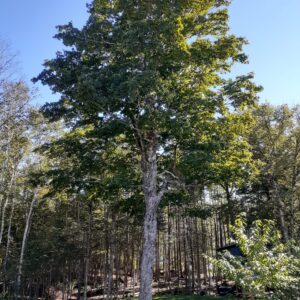Slippery Elm
(Red Elm)
Ulmus Rubra
A smaller, vase shaped tree compared with the American Elm. Native to eastern North America and occasionally planted in New Brunswick. Dutch Elm Disease has greatly reduced its population and its use as a landscape tree. Planting in isolation away from existing stands and mixed with other tree species will reduce its chance of succumbing to the disease. It has rough textured leaves that are an important food source to certain butterfly larvae including the Question Mark and Comma. Prune in late winter to avoid transmission of the disease. Wind pollinated male and female flowers are on the same tree. They appear very early before the leaves flush out with seeds maturing late spring, providing a valuable food source for local wildlife. The seeds are edible to humans and are sometimes used in salads.
Additional information
| Foliage | Deciduous |
|---|---|
| Locale | Native to North America |
| Height | Medium (30-60ft) |
| Width | Moderate |
| Form | Vase Shaped |
| Growth Rate | Fast |
| Longevity | Long (over 100 years) |
| Hardiness Zones * | 3, 4, 5 |
| Sun Exposure | Full Sun (over 6 hrs), Partial Sun (4 to 6 hrs) |
| Soil Preferences * | Moist, Slightly Acidic, Well Draining |
| Soil Tolerances | Clay, Dry, Slightly Alkaline, Wet |
| Other Tolerances | Road Salt |
| Ornamental Interest | Form |
| Wildlife Value | Birds (fruits/seeds), Butterfly Larvae (leaves), Small Mammals (fruits/seeds) |
| Human Value | Carpentry (wood), Edible (seed) |
| Seed Collection | Personally in NB |
| Planting Considerations | Shallow Roots |











